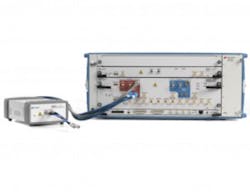Keysight Technologies today introduced a M8040A high-performance BERT for testing PAM-4 and NRZ devices that operate up to 64 Gbaud. The cloud and data center are key targets for the M8000 Series BERT, according to Ellen Spindler, product manager for BERTs at Keysight’s Digital & Photonic Test Division. An emphasis, she said in a phone interview, is on PAM-4 and other challenges of 400G data-center interconnect, with development having begun in 2014 and deployment slated for 2018.
The latest revisions of IEEE 802.3 bs and OIF CEI-56G implementation agreements define PAM-4 and NRZ interfaces for electrical backplane connections and optical interfaces for up to 400-Gb/s bandwidth. Spindler described the interfaces as ultra short reach (USR), for die-to-die connections within an MCM; extra short reach (XSR), for chip to optical engine connections within a module; very short reach (VSR), for chip to pluggable optical module connection; medium reach (MR), for chip-to-chip connections; and long reach (LR), for chip-to-chip connections over a backplane.
R&D and validation labs who need to characterize receivers for data center interconnects with PAM-4 or NRZ data rates up to 64 Gbaud are facing new test challenges, such as tighter timing margins, channel loss, nonlinearity, level interference, and crosstalk effects—making test efficiency and accuracy essential. Spindler said the new BERT’s pattern generator provides adjustable and repeatable stress conditions to verify a receiver’s tolerance margins with respect to de-emphasis, jitter, and crosstalk from an adjacent aggressor lane. In addition, it supports PAM-4 level nonlinearity measurements.The new BERT features from one to four 16/32-Gb/s channels with interactive link training and automated in situ calibration. Spindler noted that as the data-center build-out progresses towards 400 Gb/s Ethernet (400GbE), PAM-4 and NRZ will coexist, as will electrical and optical interconnects. In addition, support for four to 16 lanes (25 GbE, 50 GbE, and 200 GbE) will be necessary.
The new BERT, she said, will support fast test setups requiring few reconnections, provide repeatable and accurate results, and scale to meet future needs.
“The new 64-Gbaud BERT for PAM-4 and NRZ extends our industry leading M8000 series for 400G,” said Jürgen Beck, vice president of Keysight’s Networks and Data Centers Solutions Business, in a press release. “With its unique level of integration and scalability we enable R&D and test engineers to master the receiver test challenges for 400G data center interconnects.”
The new M8040A is the latest member of the modular AXIe-based M8000 Series. It is a highly integrated BERT that supports PAM-4 signals up to 64 Gbaud and NRZ signals up to 64 Gb/s. The pattern-generator module provides built-in de-emphasis, jitter injection, and an optional second channel. Engineers can select PAM-4 and NRZ in the user interface, eliminating the need for external combiners, cabling, and deskew to provide PAM-4 signals. For best signal quality, remote heads reduce the distance to the device under test. The analyzer module provides true PAM-4 error analysis in real-time for long PRBS and QPRBS patterns. Users can control the M8040A from a graphical and remote control interface.
The price of a M8040A BERT starts at $323,000 for a 32-Gbaud PAM-4 BERT with one channel, including the M8070A software, and is available now for ordering. More information about the Keysight M8040A 64-Gbaud BERT is available at www.keysight.com/find/m8040a.


